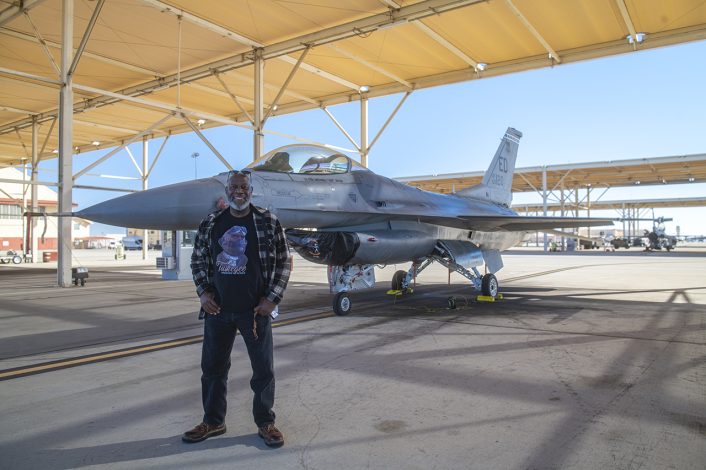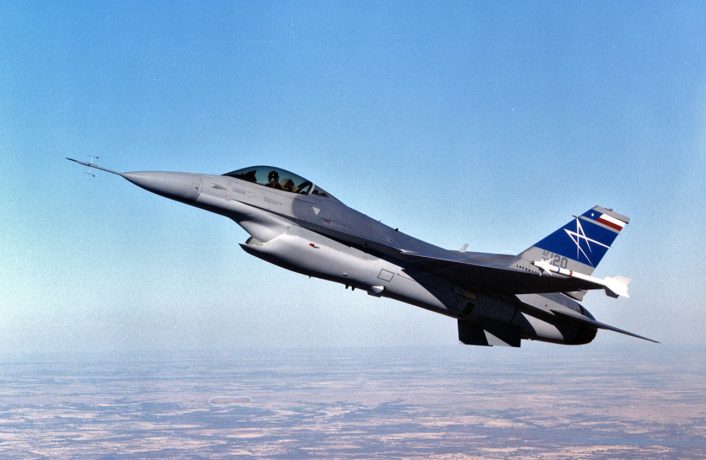The third F-16C ever built, 83-1120, flew from Edwards AFB to AMARG on May 7, 2025, ending an illustrious 41-year career.
Joining its former Edwards F-16 force compatriots, 83-1118 and 83-1119, the aircraft will become part of the extensive collection at the 309th Aerospace Maintenance and Generation Group (AMARG), Davis-Monthan AFB, near Tucson, Arizona. AMARG, commonly known as the Boneyard, is in charge of over 4,000 individual airframes, using the dry Arizona climate to store a strategic reserve of retired aircraft to support the entire U.S. military.
Almost 350 F-16s are currently in residence at AMARG. Most of these will never fly again, though on occasion some types of stored airframes are returned to service as attrition replacements.

83-1120 was the third aircraft from the F-16A production line to be set aside for upgrade to Block 25 standard, becoming an F-16C. Block 25 introduced the AN/APG-68 radar, replacing the older AN/APG-66 carried by F-16As and F-16Bs. Various models of the AN/APG-68 remain in service on F-16s worldwide, although it has now been superseded by the active electronically scanned array (AESA) AN/APG-83 radar.

Delivered straight to the testing units at Edwards AFB, where it would end up spending its whole service life, 83-1120 was used to test a range of small and large modifications throughout its career. The first major external modification came in 1994, when the aircraft was used by Lockheed Martin as a demonstrator for their F-16ES (Enhanced Strategic) model.
F-16ES added conformal fuel tanks (CFTs) and integrated surveillance and targeting sensors to the base airframe. It was put forward as a contender for procurement by Israel, but the Israeli Defense Force instead settled on a specialized variant of the F-15E Strike Eagle. On 83-1120, these modifications were dummy only, and not functional as fuel tanks or sensors, though the aerodynamic and flight characteristics data gathered on the CFT mockups was undoubtedly useful when they were later offered as their own product.
The proposded ‘Enhanced Strategic’ F-16ES (#83-1120), fitted with (dummy) conformal fuel tanks and a (dummy) FLIR turret on the nose.
[LMTAS photo] pic.twitter.com/h2P3B3Kt78
— Umair Aslam (@Defense785) January 14, 2023
Notably, Israel became one of the most prolific and famous users of F-16 CFTs, which extend the aircraft’s range without the loss of hardpoints that can be used for weapons carriage. The U.S. Air Force never opted to put CFTs into service on its own F-16s, but other nations, including Greece, Poland, and the United Arab Emirates, use them extensively.
Two years after use as the F-16ES demonstrator, 83-1120, now reverted to F-16C specification, was chosen to be fitted with a modified air intake as a proof of concept for the Lockheed Martin X-35, which would evolve into the F-35 Lightning II. The diverterless supersonic inlet (DSI) removes the requirement for a splitter plate, which on a normal F-16 is the part that separates the air intake from the body of the fuselage separating boundary layer airflow from the engine. Forward swept intake cowlings, as well as raised geometry inside the inlet, compress airflow at supersonic speeds and slows it to the subsonic speeds required by turbofan engines.

DSIs are particularly important on modern fighter designs as they offer a significant reduction in radar cross-section over older designs. The bump geometry inside the intake helps to shield the engine’s fan from radar, while the lack of a splitter plate removes an area where radar energy is very liable to become ‘trapped’, only able to be reflected straight back to the source rather than harmlessly away in different directions.
The F-35 Lightning II is the only active, publicly known U.S. Air Force aircraft with a DSI, but the design has been seen on an increasing number of Chinese designs. Even the F-22 Raptor, developed before the use of 83-1120 as a DSI testbed, instead relies on splitter plates. There is likely still some complex geometry inside the F-22’s intake intended to shield the engines. It is widely known among the aviation community that when photographing the F-22 on base visits, civilian photographers are instructed to not capture detailed front-on views of the aircraft with the intakes exposed due to the still sensitive nature of the design.

While this early F-16C has headed to the boneyard, the U.S. Air Force will continue operating the general type for many years to come. Now over 50 years old, the continual upgrades provided to the F-16 as well as continuing production for overseas customers will see its distinctive shape grace the skies for decades to come. In USAF service, F-16s are expected to remain in service well into the 2040s and possibly beyond.









